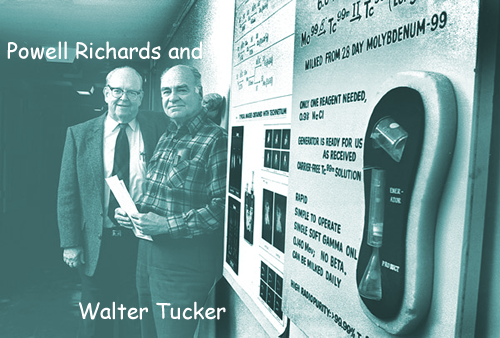The development of the first Technetium-99m Generator
This preeminent radioisotope was nearly overlooked when it was initially detected as a trace contaminant during the development of a different generator at the U.S. Department of Energy's Brookhaven National Laboratory in the 1950s. Walter Tucker and Margaret Greene were refining the product iodine-132, the "daughter" radioisotope generated from the "parent" tellurium-132. They discovered that technetium was coming from its parent, molybdenum-99, which was following the decay chemistry of tellurium-132.
Around the same time, Powell "Jim" Richards was placed in charge of radioisotope production at Brookhaven, where the team continued to refine and develop the generator. Richards realized the true potential of technetium-99m and promoted the radioisotope among the medical community. He presented the first published paper suggesting the use of technetium as a medical tracer, at the 7th International Electronic and Nuclear Symposium in Rome in June of 1960. On his way to Rome, Richards met with Paul Harper of the University of Chicago and the Argonne Cancer Research Hospital, and spent the long airplane flight extolling the merits of technetium-99m. The following year, Harper ordered the first technetium-99m generator from BNL to make blood flow measurements in patients. During his initial studies, Harper observed the rapid uptake of technetium-99m in the thyroid gland and brain tumor. These findings created an interest in technetium-99m at other institutions, and orders for generators began trickling in. Richards set up a collaboration with Harper and a colleague at the University of Chicago, Katherine Lathrop. This venture led to the development and refinement of many procedures. Important ones include the first instant kit for labeling red blood cells that was developed and patented by Richards in 1976, and later refined and patented again by Suresh Srivastava, also of BNL. Mallinckrodt Medical, B.V., now distributes these kits worldwide under the name of UltraTagRBC. Between 1963 and 1966, the interest in technetium-99m grew as its numerous applications as a radiotracer and diagnostic tool began to be described in publications. By 1966, unable to cope with the demand for technetium-99m generators, BNL withdrew from production and distribution in favour of commercial generators. These produced isotopes for a fee, to order. The first commercial generator was produced by Nuclear Consultants, Inc. of St. Louis (later taken over by Mallinckrodt), and Union Carbide Nuclear Corporation, New York. Today, scientists are still finding new uses for technetium-99m. Reported in October's New England Journal of Medicine, doctors from the University of Vermont used technetium-99m to diagnose precisely the infected lymph nodes in breast cancer patients. By injecting technetium-99m into the breast around the tumor, these doctors were able to locate the node quickly and precisely before ever making an incision. Though hundreds of thousands of generators have been produced since the very first one at Brookhaven, the Laboratory has never realized any monetary gain from this invention as it was never patented. But Richards and his colleagues have gained immeasurable satisfaction from the knowledge that their discovery, inventiveness and persistence have paid off so handsomely for patients around the world.
|
Follow me...
|



 Noticing a similarity between the tellurium-iodine parent daughter pair and the molybdenum-technetium pair, Tucker and Greene developed the first molybdenum-99/technetium-99m generator. See image on the right.
Noticing a similarity between the tellurium-iodine parent daughter pair and the molybdenum-technetium pair, Tucker and Greene developed the first molybdenum-99/technetium-99m generator. See image on the right.


